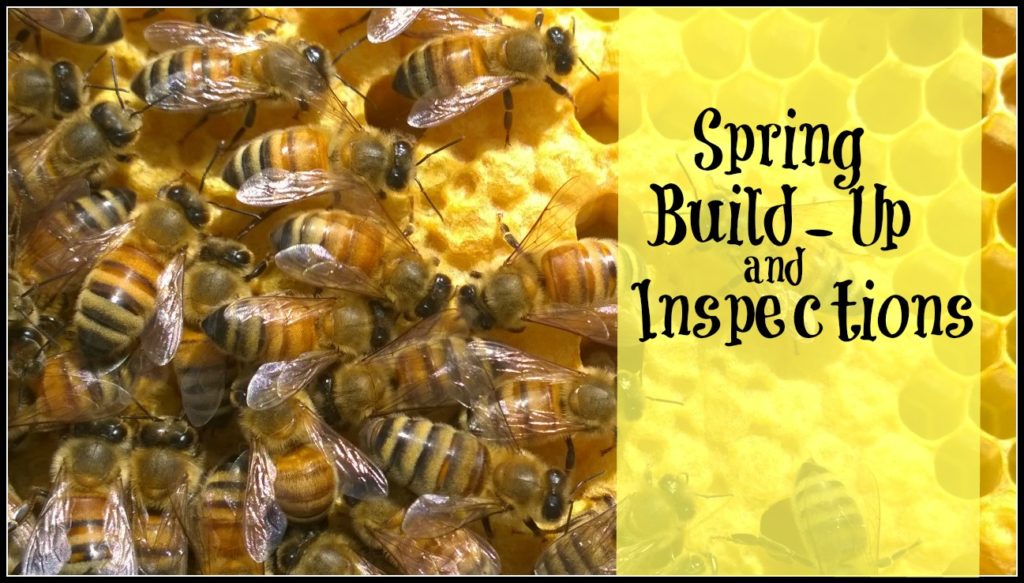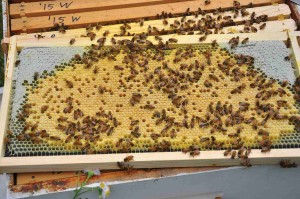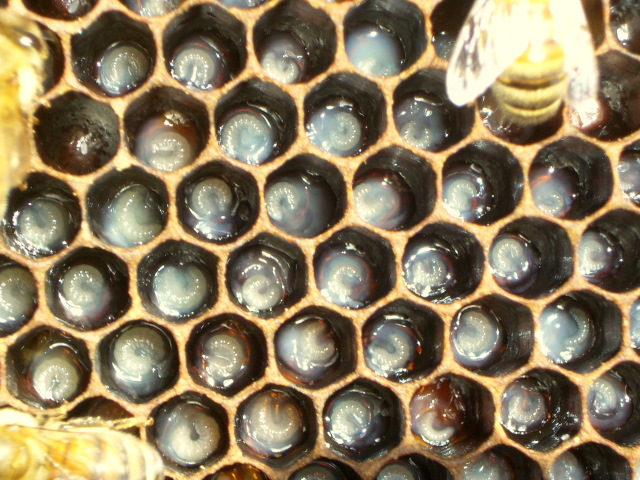
Wednesday night Anne Marie Fauvel, beekeeper and educator from Grand Valley State University, spoke to the bee club about spring her spring to-do list. Below is an overview of the information covered.
This time of year new beekeepers are always anxious to get into their hives, but aren’t entirely sure what they should be doing or looking for. Anne’s presentation covered two important components for this time of year: why a spring build-up in important and what to look for during spring hive inspections.
Spring Build-Up
One important notion to keep in mind is that peak honey flow is in July and if you want a maximum amount of healthy foragers in your hive, you need to start thinking about build-up now. Consider that the queen is busy laying eggs now and these eggs will take about 21 days to hatch, but then up to another 20-25 days until they begin foraging. This means that the eggs your queen lays May 20th will hatch around June 10th and may not begin foraging until as late as July 2. This means that today’s eggs are this summer’s foragers. This means that today’s eggs need to be healthy and strong so that tomorrow’s foragers are healthy and strong.
This brings us to hive inspections. When you inspect your hives now, what are you looking for? Well a happy, healthy queen is a crucial start. Anne identified five areas to inspect and evaluate in order to ensure you have a healthy hive.
- Pollen is coming in
An easy place to start, when you do a hive inspection, is on the outside of the hive. When you approach your hive, take a minute to observe the incoming bees. Are they carrying pollen? Pollen provides crucial protein for the brood, so you should see a lot of pollen coming in. Lack of pollen can be a sign of a dearth or may suggest that you hive is located in a less-than-ideal location.

- Brood Pattern
Once you’re inside the hive, analyzing the brood pattern (or the queen’s laying pattern) can also tell you many things about the health of the hive. A solid brood pattern can reassure you that you have a good, strong queen:
A brood pattern with a lot of holes can indicate disease or a weak queen.
However, a brood pattern can also tell you other things. For example: an otherwise solid brood pattern, with only a few empty spot, might suggest hygienic behavior (which is good!)

Additionally, when analyzing a brood pattern, remember that the queen begins laying in the middle and then moves outward in a spiral
That means that the brood in the center will be older, so empty spots in the middle may simply indicate hatching.
- Bees at All Stages of Development
As you analyze the brood frames in your hive, you want to be sure you see bees at all stages: eggs, larva, capped brood, and even the occasional new-bee just emerging into the world! Just like a brood pattern, the presence of various stages of bees also tells you what the queen has been up to. The very presence of eggs validates that you have a queen (a good tip since new beekeepers often can’t find the queen). However, a lack of capped brood, for example, may mean something caused a disruption in the laying cycle.
- Find the Queen or At Least Eggs
This is a bit redundant, but worth repeating. In order to ensure plenty of July foragers, you need a queen who is laying! It takes practice to be able to identify a queen as you stare at the mass of wriggling insects and it’s always a fun challenge to do so. However, there will be some days where you just won’t find her, or, you simply don’t have the time to play Where’s Waldo forever! In this case, as long as you can verify you have eggs in your hive, you can be assured that you have had a queen at least within the last three days. (It takes three days before eggs turns into larva.)
Finding eggs can also be a bit tricky, tho not as tricky as finding a queen who doesn’t want to be found! Eggs will be cells that look like they only contain water, at first sight. However, when you tilt the frame just right, especially in bright sun, you should be able to see tiny white eggs – almost like tiny grains of rice.
- Look for Larva in Royal Jelly
You have eggs, you can find capped brood, but how do we know the larva is healthy in between these two stages? The best way to assess this is to look for larva (this is the stage when it looks like small, white worms curled up inside the comb). Ideally we want to find lava nestled in a cup of royal jelly. This means they should be coated in shiny, milky fluid. This is indicative of healthy larva. If you do not see this, it can mean your bees aren’t bringing in enough pollen. This could be indicative of a drought, for example. It may mean you need to move your hive if there isn’t a drought, or even offer some pollen patties.
Remember, this list is not exhaustive. A large component of beekeeping is mite management, and of course, spring is the time to watch for swarming behavior and the necessity of splitting. What this list will do, though, is help you raise a strong hive, so that they have plenty of foragers to send out, come July!
Other key points …
- Know what is going on in the world around you (weather, calendar, plants, etc).- think of your bees as livestock being kept in captivity. Yes, it is important to let them do as nature requires, but you, as a responsible keeper, need to understand when to step in and supplement if necessary.
- Know what’s going on inside the hive (as covered in this post).
- Always be analyzing for effective troubleshooting.
- Monitor! Monitor! Monitor!
- Have a mentor and don’t be afraid to call him/her when needed! I think this is an absolute necessity. There are many helpful books and websites about beekeeping, but you need someone you can call or text a picture to when you just need an answer to “What is this?” or “What do I do?” You can find a mentor through the Kalamazoo Bee Club or the Northern Bee Network. The bee club has a Facebook page and there is also a Facebook group for SW Michigan Beekeepers. Make connections and don’t be afraid to use them!





Great article, so enjoyed the pictures and sure others do also. Probably the best I’ve seen in a long time
Douglas
Thanks for reading, Douglas!